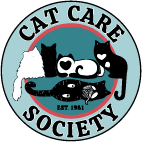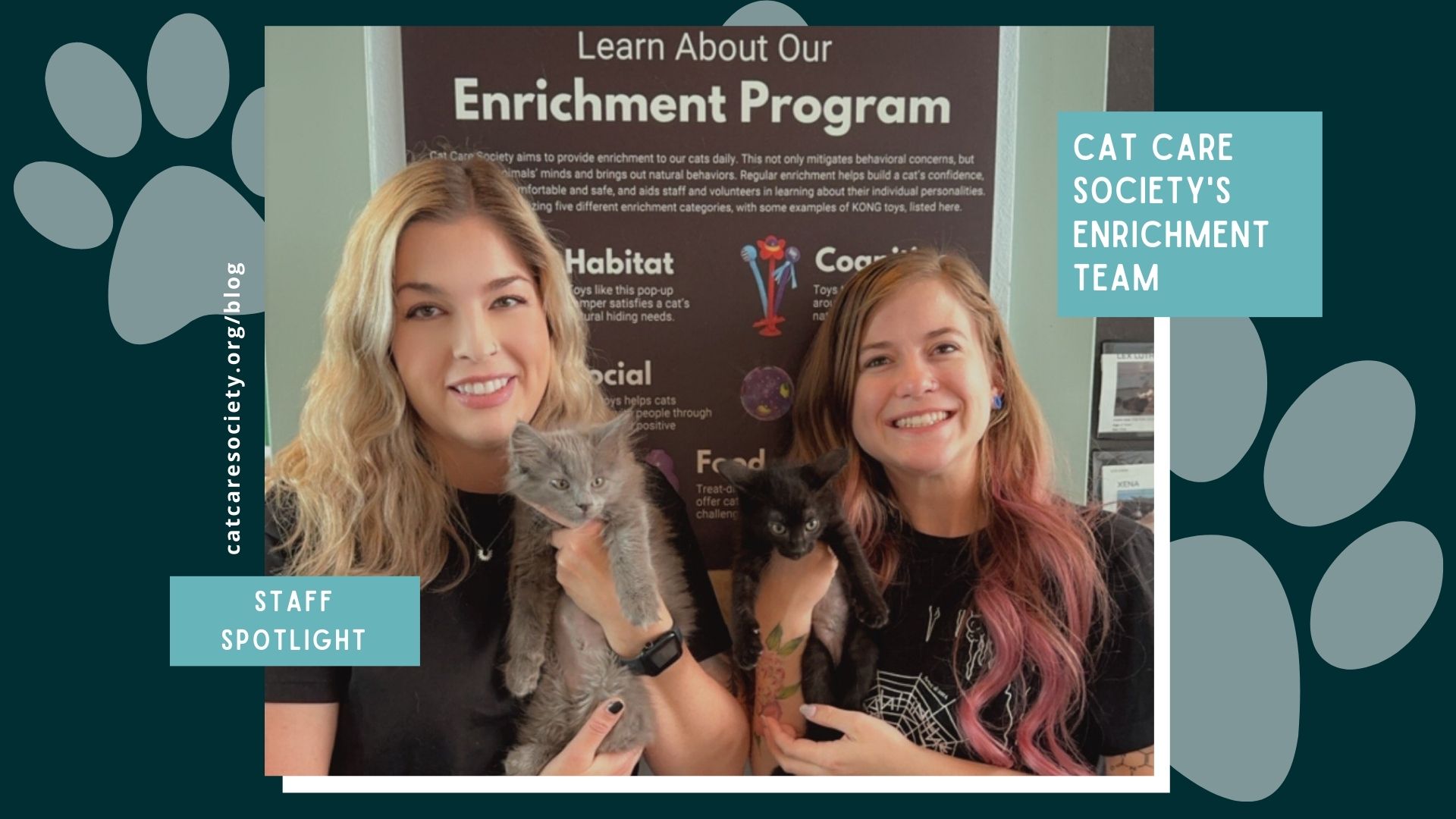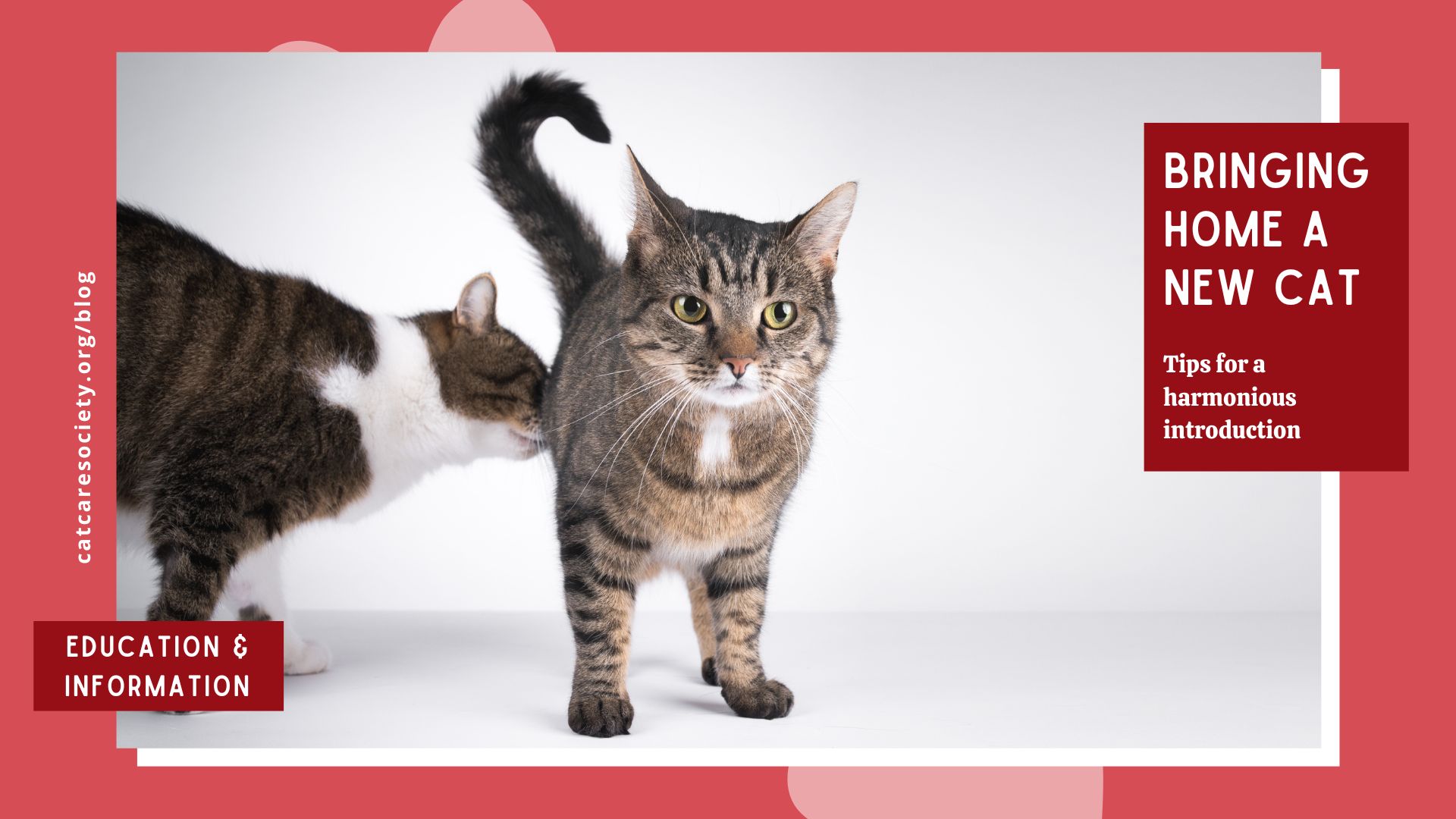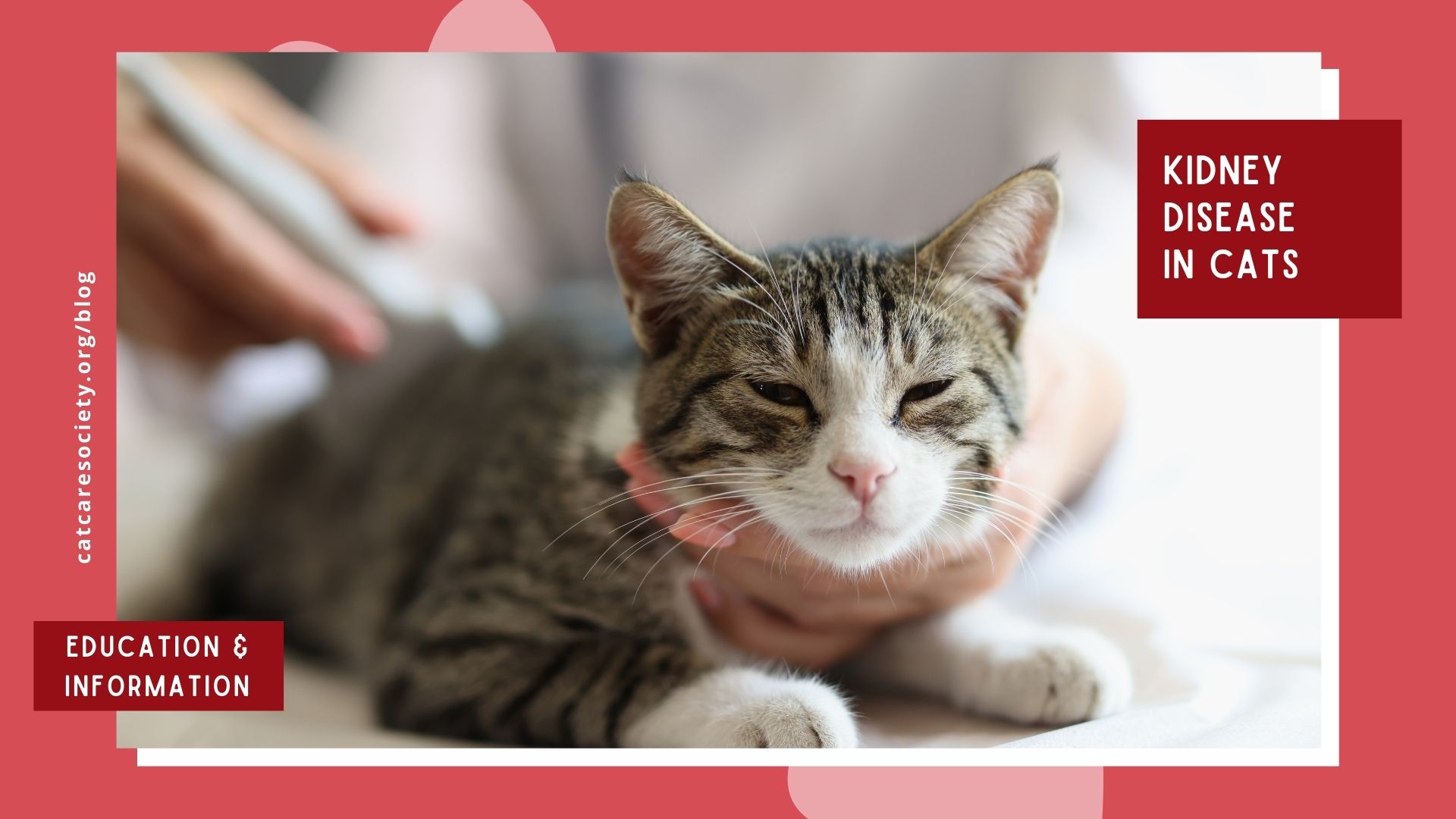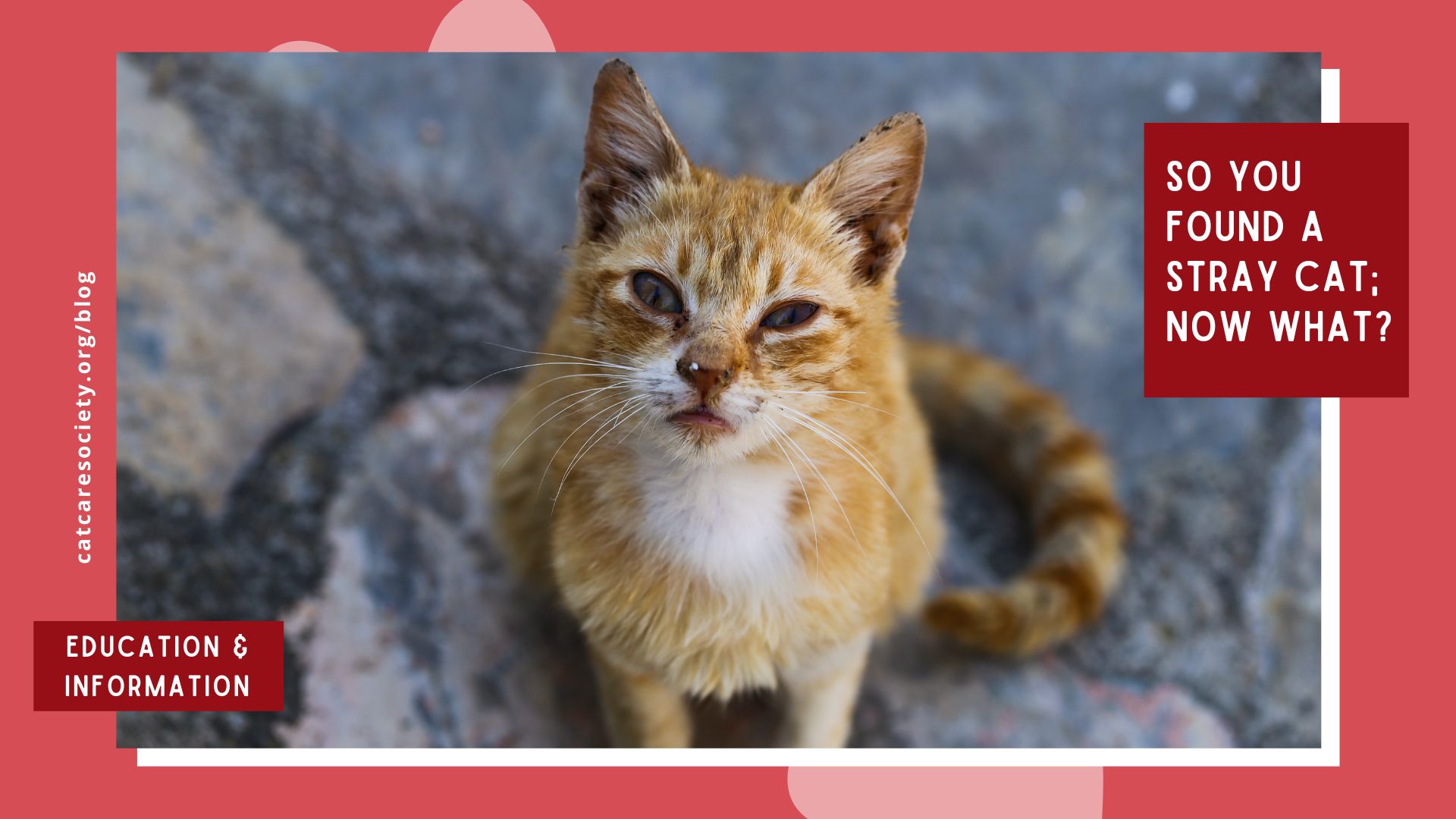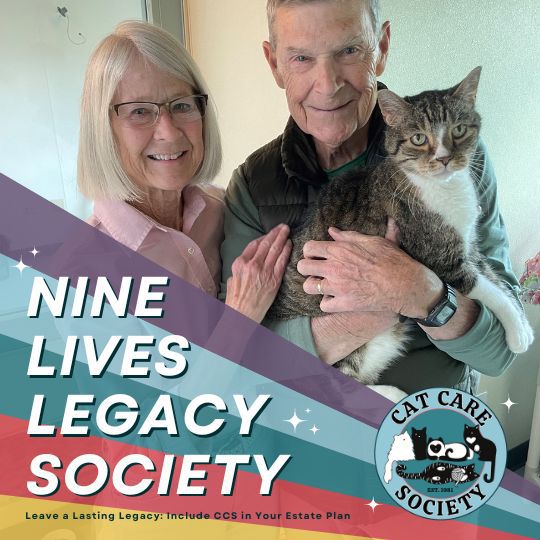Enrichment is an important element in caring for cats, especially in the often-stressful shelter environment. CCS has always had a dedicated team of volunteer socializers and animal care technicians to support cats. But when two current staff members started, they saw an opportunity to increase the impact.
One animal care tech took an interest in feline enrichment and laid the groundwork. Kelly Cunningham, now our lead enrichment specialist, created an “enrichment calendar” to use with the cats. However, with few supplies, she had to get creative, collecting paper towel rolls, crinkly paper and pipe cleaners to provide enrichment on a shoestring budget.
Once Sonia Holmstrom, CCS’ foster & behavior supervisor, joined the team last year, things took off. With a background in animal behavior and experience in zoos, she has been hard at work creating our own behavior & enrichment program. Thanks to our recent partnership, we’ve implemented KONG’s toys in the shelter to create specialized enrichment experiences for the cats.
“Since the enrichment program found funding, we were able to get more supplies, treats and toys to stock the shelf,” Kelly shared. “The kitties are spoiled with the coolest and newest cat toys on the market! Everything we use for enrichment now benefits the cats by allowing them to feel safe, comfortable and confident enough to express their natural behaviors. We’ve already seen such an improvement in the overall happiness of our cats.”
“It has been fun to build a program that targets improved mental stimulation, exercise and socialization for cats in the shelter, as well as for adopted cats,” Sonia said. “We want to see cats expressing their natural behaviors while also strengthening a bond with humans. The enrichment program has also supported our efforts with cats who need behavior modification.”
“Our shy kitties come around at a much quicker pace than before,” Kelly added. “Many of the anxious and fearful cats come out of their shell faster, and it’s because we have a dedicated team of staff and volunteers who make sure these cats are enriched and happy. Before the program, it would take some cats months to show any behavioral improvement. Now, most of them improve in weeks! This can drastically reduce the length of time they spend in the shelter. Confident cats are adoptable cats!”
What’s the difference? Cat enrichment enhances overall well-being, while behavior modification targets specific behaviors for improvement.
A cat’s enrichment is tailored to their needs based on factors like age, diet, medical needs, behavior and personal preference. A successful tailored enrichment program provides:
- Safety, predictability and consistent, positive interaction with humans
- Easy access to resources
- Personal space and vertical territory
- The choice for a cat to interact, avoid or hide
- Play/exercise opportunities & sensory stimulation
“First, I consider the environmental enrichment,” Kelly said. “The rooms are set up to fit the individual needs of the cats to reduce stress and anxiety: Where do they like to hang out? Do they like vertical space? Do they prefer to have their own ‘corner’? In a multi-cat room, this is accomplished by splitting the room into smaller areas, each spot with its own bed, food/water and litter box so each cat can claim their own space and reduce tension over territory. The furniture is strategically placed to maximize the ‘cat superhighway’ space and allow for more vertical movement. I also consider what kind of bedding they prefer, if they sleep up high or down low, if they hide/play in tunnels or use them to cross the room unseen. Many cats prefer water fountains, which are great for environmental enrichment. A variety of scratchers are also a necessity for scent-marking. I make sure to include several different kinds of toys; I put battable toys of different textures, (crinkly, soft, jingle bell) on the floor and on high surfaces. I also set out solo play toys, such as the ball & track type or interactive/motion toys. Finally, I leave out treat puzzles for cognitive stimulation. Before I leave the room, I engage in hunt and play sessions with the kitties. Our enrichment charts have a spot for comments where we write the cat’s preferences or favorite toys, which has been helpful in deciding what to use each day.”
Kelly’s favorite recent success story is Holly and Chloe, a pair who came to CCS extremely fearful and reactive. Because of their age and some medical issues, at first we did not believe they would have a successful outcome. Kelly began to visit them several times a day, playing David Teie’s cat frequency music while sitting on the floor, offering a Churu treat and some calming words and pets with a telescoping brush.
“Chloe seemed to be a bit more social and less reactive than Holly, but I was still determined to help these two feel safe and happy,” she explained. “Holly moved into her own room and relaxed only a tiny bit, so she went to a lovely behavior foster who put in so much time and effort helping her come out of her shell. Truly, Holly’s behavior would not have improved without the help of our foster. In the meantime, Chloe was moved into the shy cat room. I visited her several times a day and gave her lots of treats and attention. For a while she would remain in the hidey cube and let me pet/talk to her, but after two weeks, she would come out of the cube to greet me and solicit pets. Then I began short play sessions and offered treat puzzles (which I discovered she absolutely loved). A month or so later, Chloe had improved remarkably and was greeting most people who entered the room and showed her some attention. Holly came back from foster and joined her sibling in the room. I used the same methods on Holly then; consistently going in to sit with her, establish trust and build confidence. About a week before she got adopted, she was also coming out of the hidey bed to greet me when I approached. I truly believe these two became so confident and happy because of the dedication of our love, attention, time and enrichment we provided for them during their stay. I’m so happy they both found their forever homes. I’m so proud of how far they came!”
There can be misconceptions about what enrichment for cats. Though cats can be independent or aloof, that doesn’t mean they don’t need interaction. “Enrichment is necessary for the physical and emotional well-being of cats, which is more than just playing with them,” Kelly said. “Enrichment provides an environment that is comfortable, safe and stimulating. Enrichment gives cats the confidence to be their best selves. Imagine if you lived in a house with nothing to entertain you or make you feel at home! No comfy beds or couches, no TV, no video games, no snacks or hobbies. Life would be pretty boring. Cats are no different, and it’s our responsibility as pet owners to give our animals a fulfilling, happy life.”
To learn more, visit our Behavior & Enrichment program page!
